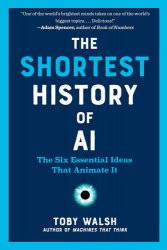The Shortest History of AI: The Six Essential Ideas That Animate It
- Добавил: literator
- Дата: 5-05-2025, 20:43
- Комментариев: 0
 Название: The Shortest History of AI: The Six Essential Ideas That Animate It
Название: The Shortest History of AI: The Six Essential Ideas That Animate ItАвтор: Toby Walsh
Издательство: Black Inc./Schwartz Books Pty Ltd.
Год: 2025
Страниц: 256
Язык: английский
Формат: pdf, epub (true)
Размер: 10.1 MB
A timely addition to the Shortest History series―everything you need to know about AI in six essential ideas.
Since Alan Turing first posed the question “Can machines think?” Artificial Intelligence has evolved from a speculative idea to a transformative force. The Shortest History of AI traces this evolution, from Ada Lovelace’s visionary work to IBM’s groundbreaking defeat of the chess world champion and the revolutionary emergence of ChatGPT. It also explores AI’s cultural journey, touching on classics such as Frankenstein, A Hitchhiker’s Guide to the Galaxy, and 2001: A Space Odyssey.
This short history is therefore divided into two parts. In the first part, I explore the early, symbolic era of Artificial Intelligence. This is a time in which computers conquered chess and many other human games. But it was also a time of frustration, when we discovered how hard it was going to be to move beyond simple games and build AI. This should be reassuring. Intelligence is complex. Building it in silicon hasn’t proved easy. In the second part of this history, I explore the more recent learning era of Artificial Intelligence. We stopped trying to program AI ourselves and instead got computers to learn to do intelligent stuff themselves. Just like you learnt to do most of the intelligent tasks you can now do, computers have now learnt to read, write and do mathematics. This brings us up to today and recent successes like the AI chatbot ChatGPT, which learnt to read a large part of the internet.
The book concludes, rather unusually for a history, by looking at the future. The history of Artificial Intelligence is far from complete. What happens when we actually succeed in building machines that think? How long will this take? And might AI be an existential threat to humanity?
Revealing how many “overnight” successes were decades in the making, this accessible and illuminating book helps us to understand how AI functions by explaining the six key ideas that animate it:
It searches for answers using predetermined symbols and means-end analysis.
It bases its answers on what sort of response it thinks it will get.
It follows a set of rules in order to simulate human expertise.
It copies the human brain by learning from experience.
It uses reinforcement learning, rewarding its own successes and punishing itself for its failures.
It uses Bayes’ theorem to calculate the probability of a cause based on its effect.
Fast-paced and rich with facts, The Shortest History of AI equips readers to understand where we’ve been―and where we’re headed.
B&W photos and illustrations throughout.
Скачать The Shortest History of AI: The Six Essential Ideas That Animate It
Внимание
Уважаемый посетитель, Вы зашли на сайт как незарегистрированный пользователь.
Мы рекомендуем Вам зарегистрироваться либо войти на сайт под своим именем.
Уважаемый посетитель, Вы зашли на сайт как незарегистрированный пользователь.
Мы рекомендуем Вам зарегистрироваться либо войти на сайт под своим именем.
Информация
Посетители, находящиеся в группе Гости, не могут оставлять комментарии к данной публикации.
Посетители, находящиеся в группе Гости, не могут оставлять комментарии к данной публикации.
